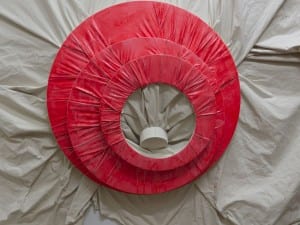Continuing their interest in bringing together old and new technologies to reinterpret information and its uses, South Kiosk gallery takes the chronovisor, a device which allegedly allows its user to browse through history, as the point of departure for Chronovisor: Archive, which runs until 20 June.
Supposedly invented by Italian priest and scientist Pellegrini Ernetti in the 1960s, the existence of the chronovisor is yet to be proven. A device which enables the completion of an archive in a fraction of the time it might normally take, the chronovisor constitutes the archivist’s holy grail: who needs a written account of the Gettysburg Address when one can visit the very moment of its recital, and capture it on film?
Traces of time and human intervention run through all of the works here, the first of which is encountered before entering the exhibition space. The placement of one of Rowena Harris’s 35cm squared concrete blocks in the doorway of the gallery has created a brutalist waiting area.
Inside there are four more of these cubes, together constituting Haul, each bearing the mark of the artist in the form of finger-gouged channel at the edge of their every plane. Hinting at a trace-of-production narrative, these markings are deliberately spaced so that, contrary to first impressions, they cannot be the remnants of the making or moving of the piece, for to attempt to pick up these works by using any of these apparent hand-holds would be impractical; futile almost.
Self-recording narrative and human intervention seem at odds in Johann Arens’ Manual, a floor-mounted, large scale printed snapshot from Google Street-view featuring a floating hand at a T-junction. To any user of the application the image is a familiar one: the street, viewed from an unusually elevated position, with its three white chevrons indicating to the user the directions in which they can browse further.
Part of this scene appears blurred, the result of Google’s policy to edit any images in which the Google camera car is captured in its own shot, as if somehow this would spoil the illusion of travelling through the streets when browsing. We are all by now comfortable with the concept of the glitch; a quick search of Google brings up endless pages of images, featuring arms ten feet long, snake-like necks, and double headed cats – rather the strange part is that Google would bother to edit the image at all, in the age of self-revelation it would seem that some illusions do still matter.
As fictitious perhaps as the chronovisor, is Mirko Smerdel’s photography device, which purports to capture the life-force, or aura, of its subject. The resulting images are as one might expect; a combination of lens-flare and over-exposure not uncommon with users of digital post-production image filtering apps, or indeed the errors produced in analogue photography. Smerdel’s device even captures the supposed ‘life-force’ of inanimate objects such as the book whose pages he has photographed for this series, which document the Gamma 60 Electronic Computer, a device contemporaneous with Ernetti’s Chronovisor.
Pellegrini Ernetti’s time-viewing machine was discredited numerous times; his refusal to unveil the machine to the public drew repeated calls for evidence of his endeavour. Ernetti’s claims to have witnessed and transcribed a performance of Thyestes, a lost tragedy from 169 BC, were called into question by experts in Latin poetry, who suggested that the error-riddled work was authored by Ernetti himself.
On another occasion a photograph of Christ on the cross was produced, only to be almost instantly revealed as a mirror image of an earlier photograph of a wood carving by Italian sculptor Lorenzo Valera. Stage props, like religious iconography, often serve the purpose of signifying a more complex idea than the mere object on which they are based. As stand-ins they possess a different object status to the genuine historical artefact, though eventually the props themselves become historical artefacts too.
In Patrick Hough’s film, Object Interviews, a selection of Egyptian-looking film props are analysed by two people; the first, an art or cultural historian, briefly acknowledges the life of the object as a film prop before talking at length on to its significance as a piece from Egyptian antiquity. The second ‘interviewer’ is an Egyptologist, and though he handles the objects as sensitively as he would any museum exhibit, he never forgets that they are replicas “designed for the European mind.”
His choice of language both vocal and physical demonstrates his intellectual revulsion at the treatment of such a historically important period by the prop-makers of the film industry. In the end the Egyptologist suggests that, were the West to cartoonise the Greeks and Romans in the way that it does the Egyptians, the whole of Western Civilisation would crumble beneath its feet.
Hough’s often humorous film reveals human subjectivity, even among experts in their field: the historian answers to the objects’ signifiers, and the Egyptologist takes their crudeness personally. How much of the analysis of history is down to conjecture we will never know, for we still await the arrival of a working chronovisor.
Other work in the exhibition uses historical objects and film to consider alternative representations of time and history. Chronovisor: Archive pulls together a range of artistic practices and successfully wraps them around the gallery’s own esoteric interests, creating, in their single-room gallery space, an exhibition that never fails to engage the viewer.
Trevor H Smith
Chronovisor: Archive, until 20 June, South Kiosk Gallery, London. For more information visit www.southkiosk.com.
Credits
1. Johann Arens’ Manual. Courtesy of the artist and South Kiosk gallery.
Follow us on Twitter @AestheticaMag for the latest news in contemporary art and culture.





